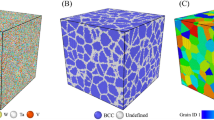Abstract
The structure of the Ni2B amorphous alloy has been investigated by the molecular dynamics method using the Heine-Abarenkov-Animalu and Animalu potentials. The amorphous state is reached by melting a microcrystal of the appropriate composition with subsequent cooling of the melt. The interatomic distances Ni-Ni, B-B, and Ni-B and the boron coordination numbers with respect to boron and nickel are determined from the calculated partial radial atomic distribution functions (RDFs). It is found that, upon transition from the crystalline state to the amorphous state, the antiprismatic-type structure transforms into the trigonalprismatic structure.
Similar content being viewed by others
References
Goldschmidt, H.,Interstitial Alloys, London: Butter-worths, 1967. Translated under the titleSplavy vnedreniya, Moscow: Mir, 1971, vol. 2.
Ishmaev, S.N., Isakov, S.L., Sadikov, I.P., Svab, E., Koszegi, L., Lovas, A., and Meszaros, Gy., Direct Evidence for B-B Contact in Amorphous Ni2B from High-Resolution Neutron Diffraction,J. Non-Cryst. Solids, 1987, vol. 94, no. 11, pp. 11–21.
Chudinov, V.G., Nurgayanov, R.R. and Lad’yanov, V.I., Specific Features of the Structure Formation upon Amorphization of the Ni-B and Zr-Be Alloys,Fiz. Tverd. Tela (S.-Peterburg), 1996, vol. 38, no. 5, pp. 1500–1504.
Dyadin, V.M., Chudinov, V.G., Gondyreva, I.L., and Bychkov, V.A.,Programma metoda molekulyarnoi dinamiki, orientirovannaya na modelirovanie fizicheskikh protsessov v VSTP (A Molecular Dynamics Program Intended for Modeling Physical Processes in High-Temperature Superconductors), Available from VINITI, 1991, Physicotechnical Inst., Ural Division, Russian Acad. of Sci., Izhevsk, no. 1537-V91-dep.
Kripyakevich, P.I.,Strukturnye tipy intermetallicheskikh soedinenii (Structural Types of Intermetallic Compounds), Moscow: Nauka, 1977.
Animaly, A.O.E., Electronic Structure of Transition Metals: I. Quantum Defects and Model Potential,Phys. Rev. B: Solid State, 1973, vol. 8, no. 8, pp. 3542–3554.
Shaw, R.V., Exchange and Correlation in Theory of Simple Metals,J. Phys. C: Solid State Phys., 1970, vol. 3, no. 5, pp. 1140–1158.
Lad’yanov, V.I., Logunov, S.P., Kuz’minykh, E.V., Zaitsev, A.V. and Korepanov, A.Yu., Thermal and Concentration Structural Transformations in the Ni-B Melts,Tezisy dokladov VII Vserossiiskoi konferentsii “Stroenie i svoistva metallicheskikh i shlakovykh rasplavov“ (Abstracts of Papers VII All-Russia Conf. “Structure and Properties of Metal and Slag Melts“), Yekate-rinburg, 1994, vol. 2, pp. 43–44.
Suzuki, K., Fukunaga, T., Ito, F. and Vatanabe, I., Dependence of Short-Range Order Structure of the Ni1-xBx Glasses on Composition, inRapidly Quenched Metallic Alloys, Schtib, S. and Warlimont, G., Eds., New York: McGraw-Hill, 1986. Translated under the titleBystrozakalennye metallicheskie splavy, Moscow: Metallurgiya, 1989.
Bakanyi, P., Panissod, P., Durand, J. and Hasegewa, R., Magnetic and NMR Study of Amorphous and Crystalline Ni-B Alloys,J Non-Cryst. Solids, 1984, vols. 61–62, pp. 1189–1193.
Author information
Authors and Affiliations
Rights and permissions
About this article
Cite this article
Stepanova, A.V., Lad’yanov, V.I., Nurgayanov, R.R. et al. Structural model of the Ni2B amorphous alloy from the data of molecular dynamics simulation. Glass Phys Chem 26, 342–345 (2000). https://doi.org/10.1007/BF02731996
Issue Date:
DOI: https://doi.org/10.1007/BF02731996



